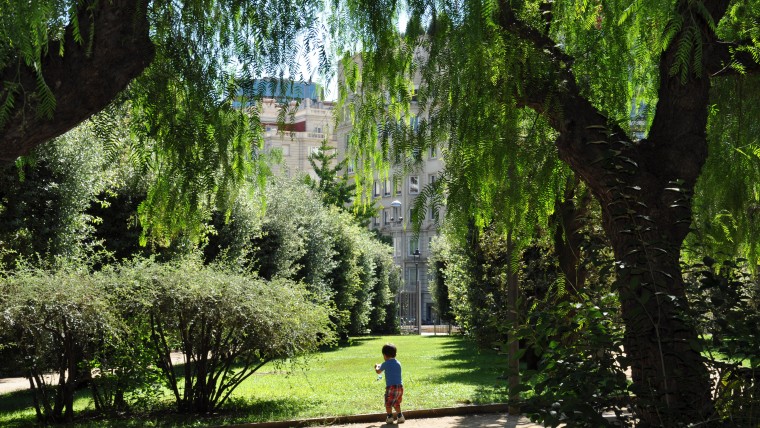
Turó Park is an elegant, cosy, welcoming place. A shady space with bosquets, ivy flowerbeds, winding paths and landscaped spots of great beauty. It has been one of Barcelona’s most iconic parks, ever since it opened at the start of the 20th century.

History
These gardens, dedicated to the poet Eduard Marquina, grew out of an old amusement park on a large estate owned by the Bertrand-Girona family, which opened in 1912 and ran until 1929. In 1917 the estate was included in the provision for Barcelona’s green spaces and therefore affected by that. When the amusement park finally closed, its owners reached an agreement with the City Council under which the central part of the land would be handed over in exchange for permission to develop the rest.
Nicolau M. Rubió i Tudurí came up with the idea of a garden, basically for local residents. But that did not come about for decades, during which time Turó Park was the only green space in the area and one of the few in the city. Over the years, despite the steady increase in the number of green spaces around Barcelona, this park has continued to have a use that goes beyond a purely local one.

Art and Architecture
Sculptures are an important feature of Turó Park. There is one by Apel·les Fenosa, dedicated to Pau Casals; another by Josep Calarà, dedicated to Francesc Viñas; Un Oiseau (A Bird), by Jean Michel Folan; and, on the grass, Eloïsa Cerdan’s La ben plantada (The Shapely Woman), a bronze sculpture that pays homage to the writer Eugeni d’Ors. Dominating the axis of the magnolia flowerbed is Joan Borrell i Nicolau’s Biga de la Font de l’Aurora (Aurora Fountain Chariot), a bronze structure representing a classical chariot pulled by horses, with a rose-bush flowerbed in front.
Art has a literary presence in this green space too. You can visit it by following a poetic route, with Federico García Lorca, Fernando Pessoa, Dylan Thomas, Sylvia Plath, Walt Whitman, Narcís Comadira, Salvador Espriu, Joan Vinyoli and Alfonsina Storni as your guides.
-
- Phone number
- Tel.: 010
-
- Titularity
- Public center
- Address:
- Av Pau Casals, 19
- Districte:
- Sarrià-Sant Gervasi
- Neighborhood:
- Sant Gervasi - Galvany
- City:
- Barcelona
Timetable
| Periode | Dies | Hores |
|---|---|---|
Horari d'hivern de l'1 de novembre al 31 de març |
Cada dia | de 08.00 h a 19.00 h |
Horari d'estiu de l'1 d'abril al 31 d'octubre |
de 08.00 h a 21.00 h |
aproximada, en funció de
l'horari solar (tanquen
quan es fa fosc, al capvespre)
Accessos: av. Pau Casals, Ferran Agulló/Tenor Viñas, Josep Bertrand/Ferran Agulló, Josep Bertrand/Francesc Pérez-Cabrero i Bori i Fontestà/Francesc Pérez-Cabrero.
Esdeveniments
-
Gimcana turística digital 'El secret del Turó Park' Open in a new window
Permanent event
-
Titelles i dansa ‘Petit vermell’ Open in a new window
19/07/2025
-
Espectacle 'Màgia en família' amb el Mag Ferbuch Open in a new window
21/06/2025
-
Concert "Gòspel Orís" Open in a new window
20/07/2025
-
Cicle d'espectacles al Turó Park Open in a new window
From 26/04/2025 to 19/07/2025
-
Titelles i música en viu ‘La Granja’ amb Teloncillo Teatro Open in a new window
05/07/2025
-
Música, art i teatre ‘Pintamúsica’ amb Viu El Teatre Open in a new window
31/05/2025
-
Clown 'Les Vacances de Madame Roulotte' amb la Bleda Open in a new window
10/05/2025
-
Concert "The Shadow of Your Smile" Open in a new window
17/05/2025
-
Contes amb cançons 'Charlie i la Fàbrica de Xocolata' amb Maleta de Musicals Open in a new window
07/06/2025
-
Concert "The Swing Duo" Open in a new window
12/07/2025
-
Contes amb cançons ‘Explica’m un conte al circ’ amb Moi Aznar Open in a new window
24/05/2025
-
Teatre de titelles ‘Palla, fusta i pedra’ amb Galiot Teatre Open in a new window
26/04/2025
-
Concert "The Dixieland Cavaliers Quartet" Open in a new window
03/05/2025
-
Concert "Duo Bresca Canta Sinatra" Open in a new window
28/06/2025
-
Concert "El Blues d’Elles" Open in a new window
14/06/2025

